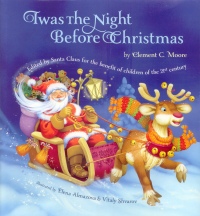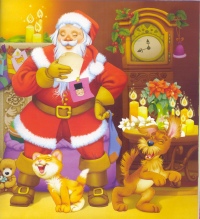| ________________
CM . . .
. Volume XIX Number 18. . . .January 11, 2013 
 |
Twas the Night Before Christmas.
Clement C. Moore. Edited by Santa Claus for the benefit of children of the 21st century. Illustrated by Elena Almazova & Vitaly Shvarov.
Vancouver, BC: Grafton & Scratch, 2012.
32 pp., hardcover, iBook, Epdf & Epub, $16.95 (hc.), $6.99 (iBook), $3.99 (Epdf), $3.99 (Epub).
ISBN 978-0-9879023-0-6 (hc.), ISBN 978-0-9879023-4-4 (iBook), ISBN 978-0-9879023-3-7 (Epdf), ISBN 978-0-9879023-2-0 (Epub).
Preschool-grade 3 / Ages 3-8.
Review by Jocelyn Reekie.
* /4
|
| |
|

excerpt:
Dear Reader,
Here at the North Pole we decided to leave all of that old tired business of smoking well behind us and I am pleased to report that we have never been healthier or happier. The reindeer asked that I confirm the fact that I have only ever worn fake fur out of respect for species that are in need of our protection, including my dear friends the arctic polar bears.
fondly, Santa Claus (From the Overleaf)
… edited by Santa Claus for the benefit of children of the 21st century. (From CIP data)
In 1822, Clement C. Moore (aka Major Henry Livingston Jr., 1748-1828) wrote a poem about a ‘jolly old elf' named Santa Claus. In the poem, Santa Claus is a selfless character who travels the world giving gifts and spreading joy. He is rotund, has a merry twinkle in his eyes, is dressed in red velvet trimmed with white fur, and he smokes a pipe. The details of the original version depict a household, characters, attire, and behaviour of the time it was written, the 19th century. What transcends time is the fact that many of the things Livingston describes in his poem are universal truths, and things we admire. Removing lines and changing words does not change that, but it does take something away from the whole.
In this version, an editor claiming to be Santa Claus has cut two lines: "The stump of a pipe he held tight in his teeth, And the smoke it encircled his head like a wreath." He/she has also changed the word "breast" in the line "The moon on the breast of the new-fallen snow," to "crest." The line now reads, "The moon on the crest of the new-fallen snow." Donder's name has been changed to Donner. And in the second to last line, "But I heard him exclaim, ere he drove out of sight," is now, "But I heard him exclaim, as he drove out of sight.
Therefore, I have to assume this editor does not believe children can differentiate between the past and the present or understand the world is a place of constant dynamic change. Nor should they be exposed to the word "breast" or asked to cope with old-fashioned words such as "ere." And a name is changeable on a whim.
At the same time, children are asked to believe Santa Claus wore only faux fur. In the 19th century, there was no such sensitivity to peoples of the north wearing fur. In fact, it was considered the sensible thing to do if one did not want to freeze to death. Faux fur did not exist, so is the editor trying to change history? Confusing to young people, no?
 As confusing, if one is trying to impose a ‘modern' view on the work as a whole, would be the illustrations which clearly depict a place of the past. Most people would be appalled to know they have mice romping about in their modern homes (although they certainly do still inhabit some houses), and, though people do continue to light candles in homes nowadays, no one who has any respect for fire would light candles and set them on tree boughs indoors.
As confusing, if one is trying to impose a ‘modern' view on the work as a whole, would be the illustrations which clearly depict a place of the past. Most people would be appalled to know they have mice romping about in their modern homes (although they certainly do still inhabit some houses), and, though people do continue to light candles in homes nowadays, no one who has any respect for fire would light candles and set them on tree boughs indoors.
On a more upbeat note, the illustrations, themselves, are bright and bold and rich with colour and details that catch a child's eye. My 2½-year-old granddaughter looked long and hard at them—not because they instilled a sense of modernity in her. That said, it was Livingston's lines, themselves, that gave her the most delight, particularly:
Now Dasher, now Dancer, now Prancer and Vixen!
On Comet, on Cupid on Donder and Blitzen! [I used Livingston's name when I read it to her.]
To the top of the porch, to the top of the wall!
Now dash away, dash away, dash away all!
It is this reader's belief that a very large part of the charm, and the benefit, of reading a classic to a child or encouraging children to read it themselves is to give the children a window to other times and places, and to allow children the delights of seeing and experiencing them as they existed. After all, a book does not become a classic until a good deal of time has passed since its writing, and the world is a dynamic and ever-changing place. Without windows to the past, we would not know what belief systems did exist, or what life was like.
Finally, while the editor claims to have made these changes for the benefit of children of the 21st century, the editor does not name himself/herself. Instead, said editor wants kids to believe he/she is Santa Claus. Really?
Not Recommended.
Jocelyn Reekie is an author, editor and publisher in Campbell River, BC.

To comment
on this title or this review, send mail to cm@umanitoba.ca.
Copyright © the Manitoba Library Association. Reproduction for personal
use is permitted only if this copyright notice is maintained. Any
other reproduction is prohibited without permission.
NEXT REVIEW |
TABLE OF CONTENTS FOR THIS ISSUE
- January 11, 2013.
AUTHORS |
TITLES |
MEDIA REVIEWS |
PROFILES |
BACK ISSUES |
SEARCH |
CMARCHIVE |
HOME |

 As confusing, if one is trying to impose a ‘modern' view on the work as a whole, would be the illustrations which clearly depict a place of the past. Most people would be appalled to know they have mice romping about in their modern homes (although they certainly do still inhabit some houses), and, though people do continue to light candles in homes nowadays, no one who has any respect for fire would light candles and set them on tree boughs indoors.
As confusing, if one is trying to impose a ‘modern' view on the work as a whole, would be the illustrations which clearly depict a place of the past. Most people would be appalled to know they have mice romping about in their modern homes (although they certainly do still inhabit some houses), and, though people do continue to light candles in homes nowadays, no one who has any respect for fire would light candles and set them on tree boughs indoors.